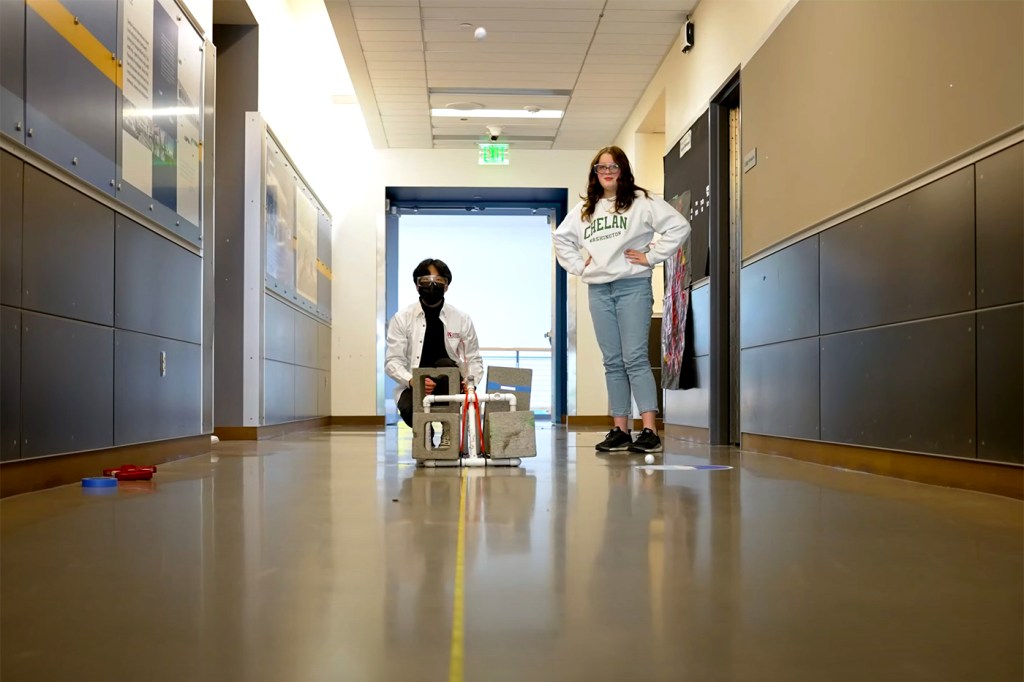Northeastern doctoral student’s documentary looks to future of public education

Thomas Edison made 1,000 unsuccessful attempts at inventing the light bulb. When a reporter asked, “How did it feel to fail 1,000 times?” Edison replied, “I didn’t fail 1,000 times. The light bulb was an invention with 1,000 steps.”
Kaci Salnick opens her documentary–aptly named “One Thousand Steps”–with these words and spends the next 40 minutes unpacking how Highline Public Schools, a public school district in Washington State, has attempted its own innovations in public education.
How can public schools innovate when faced with funding and resource challenges? What does innovation look like and how does it work with, not against, the existing public education system?
As a former Seattle public high school teacher, Salnick has asked these questions herself. Now, she’s looking for answers–or at least an opportunity to spark a conversation–through her doctoral program at Northeastern’s Seattle campus. Ultimately, she hopes her work will help showcase the challenges public schools face–and how some people have found ways to innovate despite them.
In the case of Highline, the district created three specialized high schools that provide students with more options both inside and outside the classroom.
“I have become convinced that the more we allow schools to do this, the more schools will be allowed to do things like this,” Salnick says. “The more that we show that ‘We didn’t have two nickels to rub together, but we found a way to do this,’ that raises us all up.”
After conducting interviews with educators from districts across Washington state, Salnick settled on Highline as her research focus, largely because “there’s nothing on its face that would particularly set them apart.”
The district serves about 17,500 K-12 students in five different cities slightly south of Seattle. About 40% of students in Highline identify as Hispanic, and, as Salnick says, the district doesn’t have particularly “deep pockets.” However, Highline has spent the better part of 20 years expanding its high school options beyond its four traditional, comprehensive high schools–Evergreen, Highline, Mount Rainier and Tyee.
The district created three high schools that, to varying degrees, offer more non-traditional high school experiences: Big Picture, Maritime and Raisbeck Aviation.
Each school operates in a different “context,” Salnick says. Raisbeck Aviation is a more traditional high school with an emphasis on STEM education, specifically aviation. Meanwhile, Big Picture aims to customize education around each student’s interests. It strays away from the typical 9 a.m. to 3 p.m. schedule with internships two days every week and has done away with grades and credits. Maritime is somewhere in between these two options. It doesn’t have letter grades–opting for a “mastery-based approach,” Salnick says–but hews closer to the traditional high school experience.
Each school accepts students based on a lottery system, like the rest of the district’s high schools.
How did Highline, a relatively normal public school district, create three more innovative high school offerings? Salnick says it wasn’t easy.
Finding someone, let alone someone in a position of power, willing to take a risk in a risk-averse field like public education is a massive barrier for districts like Highline.
“I spoke with someone in the interview stage who tried to start a school like this in a district, and they thought they were about to do it,” Salnick says. “They had meetings with this person and that person and at every stage it was happening, and then when it came time for someone to actually say yes, nobody was willing to say yes. Nobody ever said no, but nobody was willing to say yes.”
To make any meaningful change requires having someone who is a “lightning rod,” she says. In Highline’s case, that was Reba Gilman, the founding principal of Reisbeck Aviation. But in a field where burnout and turnover is high, consistency of vision is not always a possibility.
“[Gilman] spent years gathering funding, talking to people, convincing the district it was a good idea, figuring out where they could have a building,” Salnick says.
In the case of schools like Big Picture and Maritime, Highline also had to find creative ways to make grade-less, credit-less schools work in a system that has testing standards and graduation requirements.
Salnick says Highline’s approach has helped increase student engagement and, in turn, retention in the district.
“When you see people leaving the district for other options, that’s enrollment and money and all sorts of things out the door,” Salnick says. “By Highline opening up to offering some different options, I think they’ve kept more students in the district.”
There are some elements of Highline’s approach that, as a former public school teacher, make Salnick slightly uneasy. Both Raisbeck Aviation and Maritime received grants from private industry to get started. Salnick says she bristles at the thought of a T Mobile High School, but understands Highline’s schools stopped receiving private grants after the initial startup cost.
After she finishes her degree this spring, Salnick means to return to the classroom. She says it’s tough for teachers right now, between a teacher shortage caused by an alarming rate of burnout and legislators attempting to ban books and control how and what educators teach. But despite all that, her research has given her hope.
“I would love to see these alternative models be replicated more once people see how it’s done,” Salnick says. “I think it’s easier to do something when you see how someone else has done it.”
Salnick encourages those who watch the documentary to provide feedback that will inform her research and understanding of innovations in public schools.
For media inquiries, please contact media@northeastern.edu.






